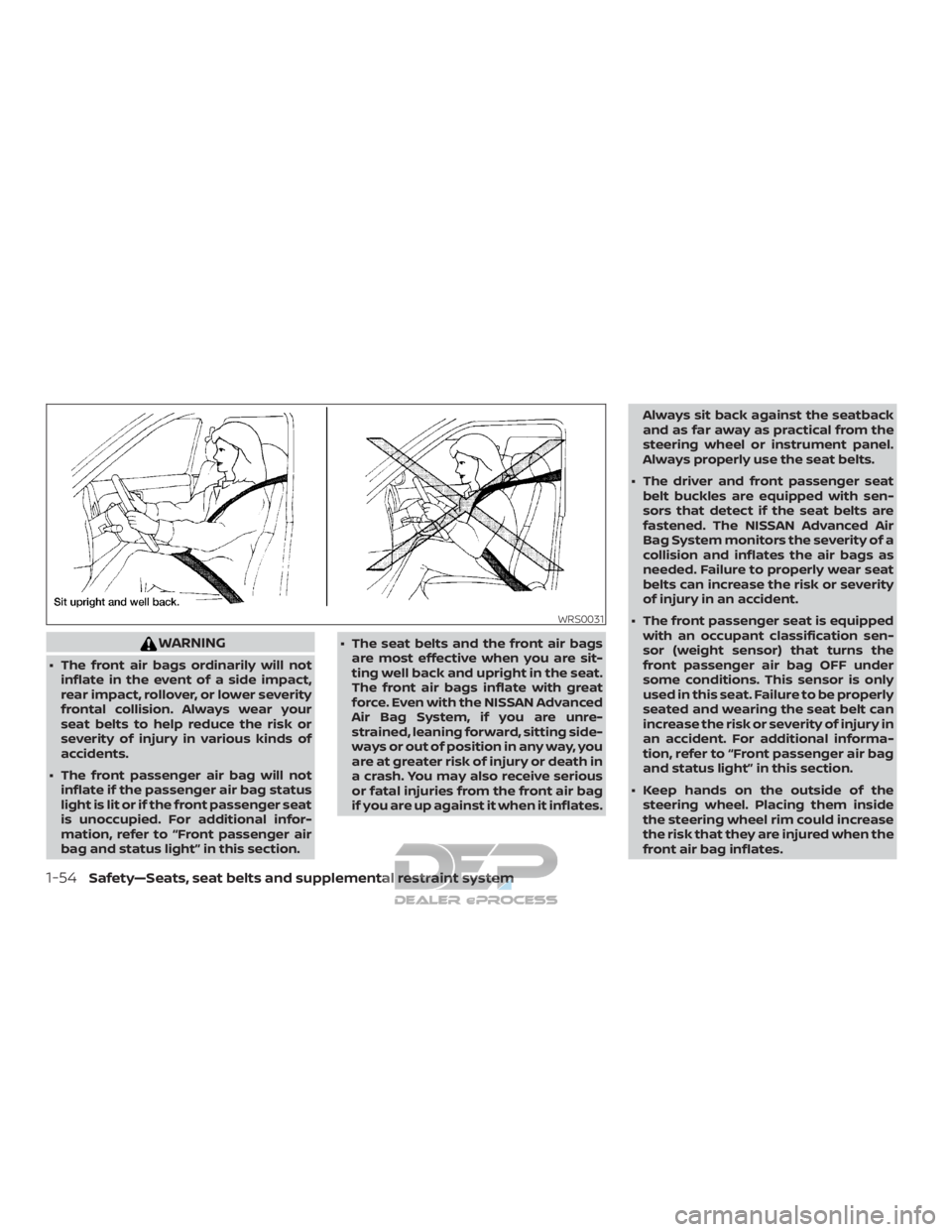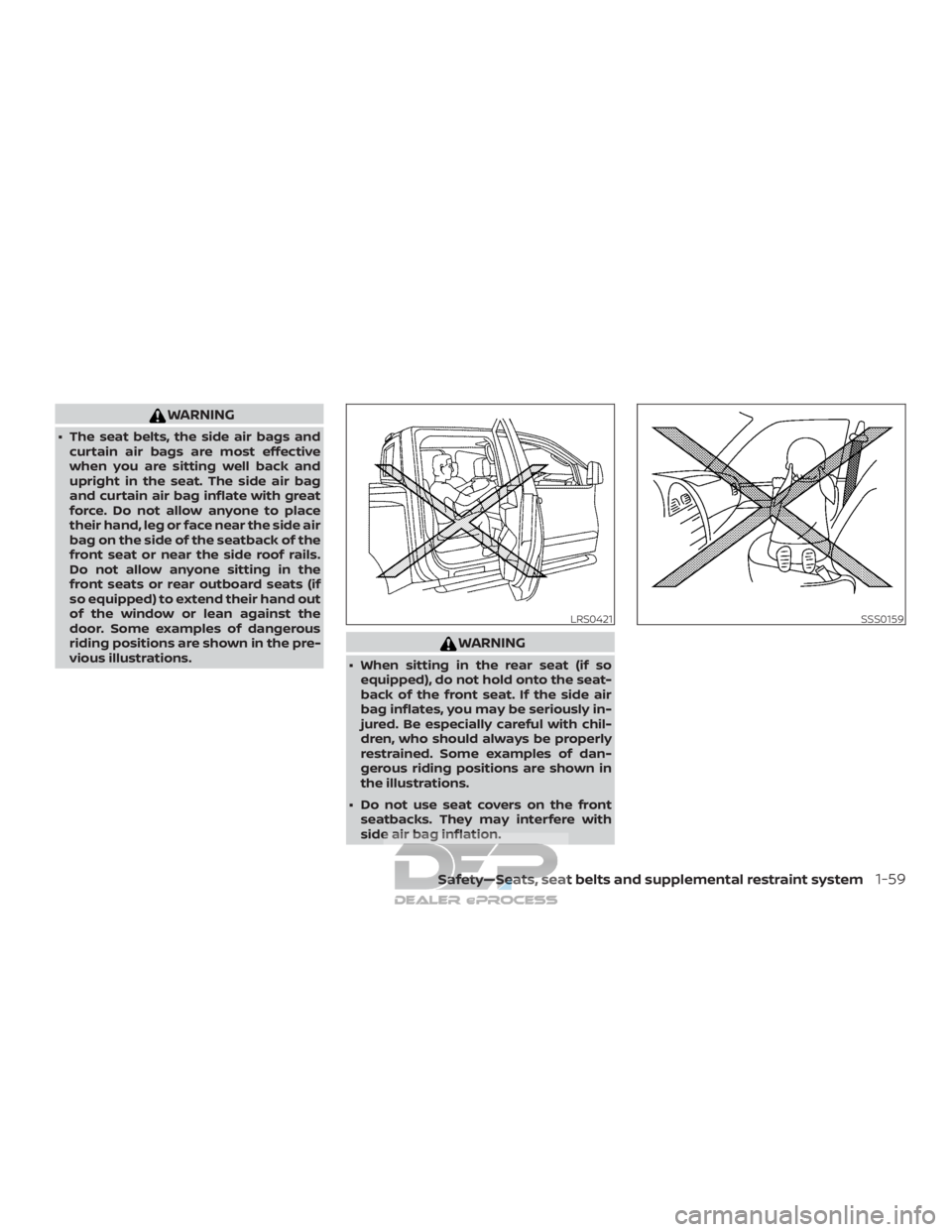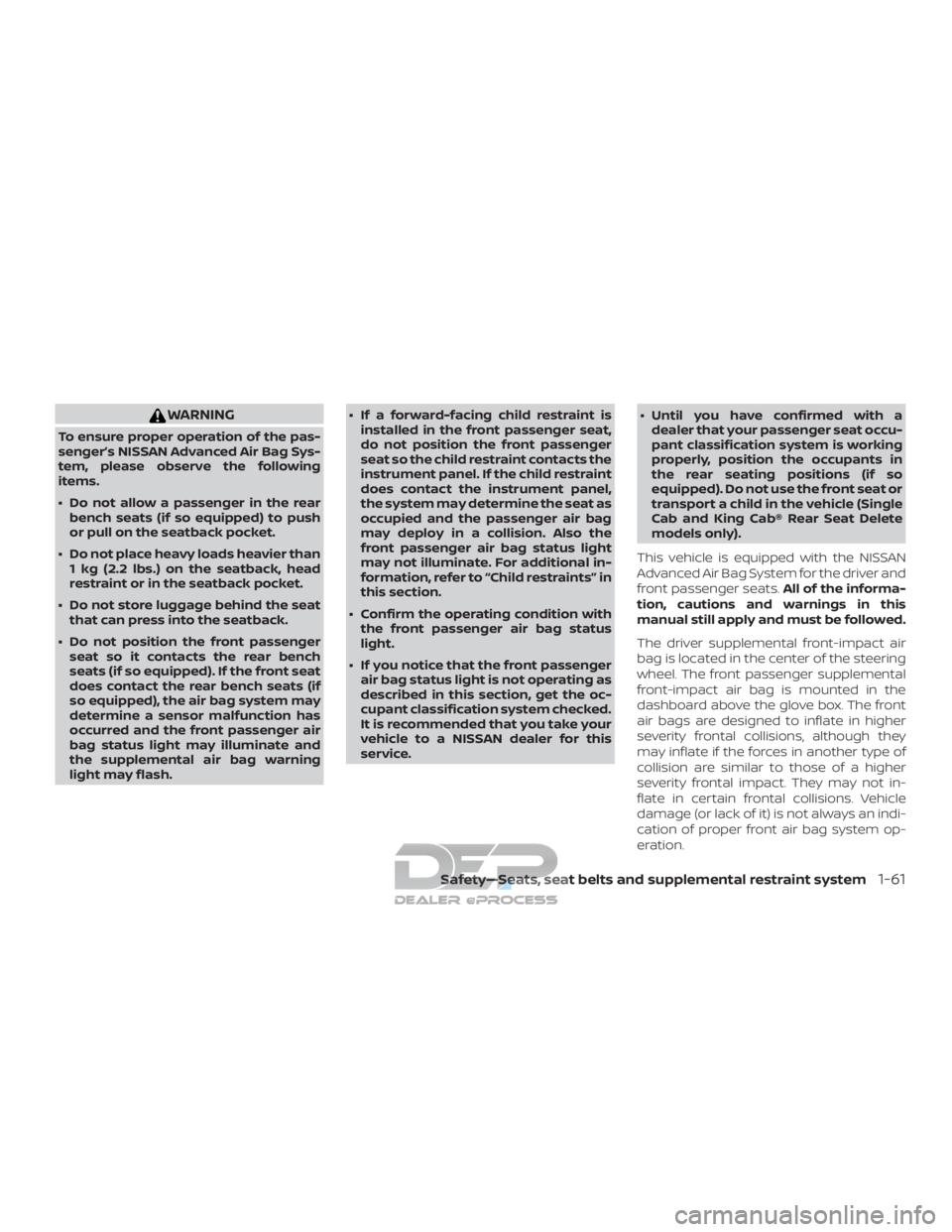Page 95 of 682

WARNING
∙ The front air bags ordinarily will notinflate in the event of a side impact,
rear impact, rollover, or lower severity
frontal collision. Always wear your
seat belts to help reduce the risk or
severity of injury in various kinds of
accidents.
∙ The front passenger air bag will not inflate if the passenger air bag status
light is lit or if the front passenger seat
is unoccupied. For additional infor-
mation, refer to “Front passenger air
bag and status light” in this section. ∙ The seat belts and the front air bags
are most effective when you are sit-
ting well back and upright in the seat.
The front air bags inflate with great
force. Even with the NISSAN Advanced
Air Bag System, if you are unre-
strained, leaning forward, sitting side-
ways or out of position in any way, you
are at greater risk of injury or death in
a crash. You may also receive serious
or fatal injuries from the front air bag
if you are up against it when it inflates. Always sit back against the seatback
and as far away as practical from the
steering wheel or instrument panel.
Always properly use the seat belts.
∙ The driver and front passenger seat belt buckles are equipped with sen-
sors that detect if the seat belts are
fastened. The NISSAN Advanced Air
Bag System monitors the severity of a
collision and inflates the air bags as
needed. Failure to properly wear seat
belts can increase the risk or severity
of injury in an accident.
∙ The front passenger seat is equipped with an occupant classification sen-
sor (weight sensor) that turns the
front passenger air bag OFF under
some conditions. This sensor is only
used in this seat. Failure to be properly
seated and wearing the seat belt can
increase the risk or severity of injury in
an accident. For additional informa-
tion, refer to “Front passenger air bag
and status light” in this section.
∙ Keep hands on the outside of the steering wheel. Placing them inside
the steering wheel rim could increase
the risk that they are injured when the
front air bag inflates.
WRS0031
1-54Safety—Seats, seat belts and supplemental restraint system
Page 96 of 682
∙ The air bag system monitors the se-verity of a collision and then inflates
the air bags as needed. Failure to
properly wear seat belts can increase
the risk or severity of injury in an
accident.
ARS1133
Safety—Seats, seat belts and supplemental restraint system1-55
Page 97 of 682
WARNING
∙ Never let children ride unrestrained orextend their hands or face out of the
window. Do not attempt to hold them
in your lap or arms. Some examples of
dangerous riding positions are shown
in the illustrations.
WARNING
∙ Children may be severely injured orkilled when the front air bags, side air
bags or curtain air bags inflate if they
are not properly restrained. Pre-teens
and children should be properly re-
strained in the rear seat (if so
equipped), if possible.
ARS1041ARS1042ARS1043
1-56Safety—Seats, seat belts and supplemental restraint system
Page 98 of 682
WARNING
∙ Even with the NISSAN Advanced AirBag System, never install a rear-
facing child restraint in the front seat.
An inflating air bag could seriously in-
jure or kill a child. A rear-facing child
restraint must only be used in the rear
seat (if so equipped).
ARS1044ARS1045WRS0256
Safety—Seats, seat belts and supplemental restraint system1-57
Page 99 of 682
WARNING
Front seat-mounted side-impact
supplemental air bags and roof-
mounted curtain side-impact and roll-
over supplemental air bags:
∙ The side air bags and curtain air bagsordinarily will not inflate in the event
of a frontal impact, rear impact, or
lower severity side collision. Always
wear your seat belts to help reduce
the risk or severity of injury in various
kinds of accidents.
Do not lean against doors or windows.
WRS0431
Do not lean against doors or windows.
LRS0396
Do not lean against doors or windows.
SSS0162
1-58Safety—Seats, seat belts and supplemental restraint system
Page 100 of 682

WARNING
∙ The seat belts, the side air bags andcurtain air bags are most effective
when you are sitting well back and
upright in the seat. The side air bag
and curtain air bag inflate with great
force. Do not allow anyone to place
their hand, leg or face near the side air
bag on the side of the seatback of the
front seat or near the side roof rails.
Do not allow anyone sitting in the
front seats or rear outboard seats (if
so equipped) to extend their hand out
of the window or lean against the
door. Some examples of dangerous
riding positions are shown in the pre-
vious illustrations.
WARNING
∙ When sitting in the rear seat (if soequipped), do not hold onto the seat-
back of the front seat. If the side air
bag inflates, you may be seriously in-
jured. Be especially careful with chil-
dren, who should always be properly
restrained. Some examples of dan-
gerous riding positions are shown in
the illustrations.
∙ Do not use seat covers on the front seatbacks. They may interfere with
side air bag inflation.
LRS0421SSS0159
Safety—Seats, seat belts and supplemental restraint system1-59
Page 101 of 682
NISSAN Advanced Air Bag System
(front seats)
1. Roof-mounted curtain side-impactand rollover supplemental air bag infla-
tors
2. Roof-mounted curtain side-impact and rollover supplemental air bags
3. Air bag Control Unit (ACU)
4. Supplemental front-impact air bag modules
5. Crash zone sensor
6. Occupant classification sensor (weight sensor)
7. Occupant classification system control unit
8. Seat belt buckle switches
9. Seat belt with pretensioner(s) (front seats)
10. Front seat-mounted side-impact supplemental air bag modules
11. Satellite sensor
LRS3116
1-60Safety—Seats, seat belts and supplemental restraint system
Page 102 of 682

WARNING
To ensure proper operation of the pas-
senger’s NISSAN Advanced Air Bag Sys-
tem, please observe the following
items.
∙ Do not allow a passenger in the rearbench seats (if so equipped) to push
or pull on the seatback pocket.
∙ Do not place heavy loads heavier than 1 kg (2.2 lbs.) on the seatback, head
restraint or in the seatback pocket.
∙ Do not store luggage behind the seat that can press into the seatback.
∙ Do not position the front passenger seat so it contacts the rear bench
seats (if so equipped). If the front seat
does contact the rear bench seats (if
so equipped), the air bag system may
determine a sensor malfunction has
occurred and the front passenger air
bag status light may illuminate and
the supplemental air bag warning
light may flash. ∙ If a forward-facing child restraint is
installed in the front passenger seat,
do not position the front passenger
seat so the child restraint contacts the
instrument panel. If the child restraint
does contact the instrument panel,
the system may determine the seat as
occupied and the passenger air bag
may deploy in a collision. Also the
front passenger air bag status light
may not illuminate. For additional in-
formation, refer to “Child restraints” in
this section.
∙ Confirm the operating condition with the front passenger air bag status
light.
∙ If you notice that the front passenger air bag status light is not operating as
described in this section, get the oc-
cupant classification system checked.
It is recommended that you take your
vehicle to a NISSAN dealer for this
service. ∙ Until you have confirmed with a
dealer that your passenger seat occu-
pant classification system is working
properly, position the occupants in
the rear seating positions (if so
equipped). Do not use the front seat or
transport a child in the vehicle (Single
Cab and King Cab® Rear Seat Delete
models only).
This vehicle is equipped with the NISSAN
Advanced Air Bag System for the driver and
front passenger seats. All of the informa-
tion, cautions and warnings in this
manual still apply and must be followed.
The driver supplemental front-impact air
bag is located in the center of the steering
wheel. The front passenger supplemental
front-impact air bag is mounted in the
dashboard above the glove box. The front
air bags are designed to inflate in higher
severity frontal collisions, although they
may inflate if the forces in another type of
collision are similar to those of a higher
severity frontal impact. They may not in-
flate in certain frontal collisions. Vehicle
damage (or lack of it) is not always an indi-
cation of proper front air bag system op-
eration.
Safety—Seats, seat belts and supplemental restraint system1-61